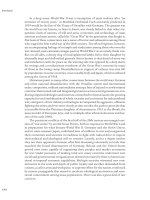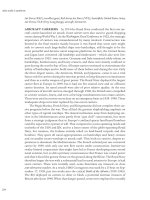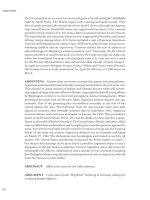The concise encyclopedia of world war II 2 volumes (greenwood encyclopedias of modern world wars) ( PDFDrive ) 236
Bạn đang xem bản rút gọn của tài liệu. Xem và tải ngay bản đầy đủ của tài liệu tại đây (73.26 KB, 1 trang )
Biological Warfare
and understrength during the Balkan campaign (1940–1941) and again during the
desert campaigns (1940–1943).
BIOLOGICAL WARFARE Japan used biological weapons against civilian
and military concentrations throughout its occupied territories, especially China,
starting in the 1930s. The Japanese worked outward from facilities in Manchuria
run by the ultranationalist surgeon and sadist, Shiro
ˉ Ishii, who performed biological experiments on prisoners of war and civilians at his infamous Unit 731. Documentation of these horrors is only partial: the United States captured Ishii’s papers at
the end of the war, but they were returned to Japan in 1958. Japanese authorities
have since repressed the fi les. However, partial fi le records were microfi lmed before
their return to Japan, the Chinese made several reports, and Western Allied interrogators also gleaned information from prisoner interrogations. What is known
from these sources is that delivery of Japanese biological weapons was simple: rats
with plague-infected fleas were inserted or dropped on targets, or infected grain,
animals, or people were sent into target areas. At Unit 731 work was also done on
more sophisticated weapons. These included the “Ha bomb” for delivery of tetanus
and anthrax on the battlefield via infected shrapnel, and the “Uji bomb” to spread
cholera, bubonic plague, and other plagues among civilians and hoof-and-mouth
and anthrax to farm animal populations. Work was done on a variety of delivery
systems to distribute animal, plant, and human diseases, including attaching infected matter to high altitude balloon bombs, or Fugo, to attack North America.
Several thousand experimental incendiary Fugo were launched. It was hoped that
later balloon barrages would carry disease across the Pacific, but Japan lost the war
before this could be tried.
Japan conducted limited but widespread biological warfare throughout China
and possibly also parts of Southeast Asia, from the Dutch East Indies to Burma
and Malaya. There may have been targeting of some jungle tribes and hill people
for complete extermination, but the majority of casualties were Chinese. Attacks
were made with “germ bombs” containing anthrax, typhoid, and various other
pathogens. First use likely was by local Japanese Army commanders in 1938. There
is some evidence to suggest that the Japanese also used biological weapons against
Russian and Mongolian troops at Nomonhan in 1939, delivered into the water supply by suicide troops. Biological weapons were certainly used at Ningbo in 1940, at
Ch’ang-te in 1941, and on a massive scale against Guomindang troops in southern
China in 1942. Food supplies were deliberately contaminated, though the widely
believed story of infected chocolate delivered to children is based on suspect records and unreliable testimony from a postwar Soviet show trial of accused Japanese war criminals held at Khabarovsk in 1949. Plague rats and their attendant
fleas were on the way for use against U.S. forces on Saipan, but the transport carrying them was sunk en route. The Japanese hoped to use biological weapons to
attack the United States itself from a distance, utilizing Fugo. An epidemic of
plague carried by lab rats released by Unit 731 at the end of the war is estimated
to have taken 30,000 lives around Harbin in 1947, after a two-year incubation and
migration period.
159









